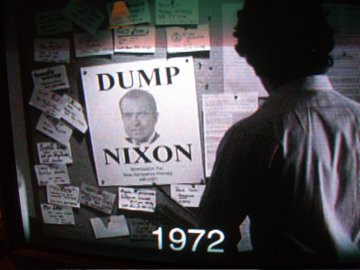As a great sports talk show guy has been heard to say, it’s not my style to criticize. So I’m not going to get exercised by the Chevy truck ad campaign that’s airing during this year’s baseball playoffs. I’m not going to get upset by the campaign’s appropriation of iconic images from our recent history–Rosa Parks, Martin Luther King Jr., Muhammad Ali, Nixon’s White House departure, a Vietnam combat scene and a Vietnam peace march, a Woodstock clip, New York firefighters, the shafts of light memorializing the World Trade Center, NewOrleans after the flood (which begins a sequence suggesting Chevy trucks have had a big part in helping New Orleans put itself back together). I’m not going to drone on about the irony in John Mellencamp, whose song “Our Country” is the ads’ soundtrack, praising G.M. as a company that looks out for working folk with the company in the midst of putting tens of thousands of people out of their jobs. I won’t so much as mention that Mellencamp is performing the song before Game 2 of the World Series, in effect giving G.M. a free ad for its trucks.
(I might do all those things, but others have beat me to it, including someone who put up a somewhat predictably but still sharp parody on YouTube.)
What I will do is suggest a few clips Chevy might want to add to its paean to itself; or better yet, use them to do a whole new ad.
–GM workers fighting cops and company goons as they sought to organize their plants in the 1930s.
–Street scenes from Flint and other towns GM and other automakers have abandoned. I’m sure Michael Moore would share some of his footage.
–Some film of the Corvair; maybe spliced together with some images of Ralph Nader when he outed the car as “unsafe at any speed.”
–Maybe shots from a GM board meeting where the auto geniuses plot their winning market response to Toyota, Nissan, Honda et al. You could have clips from the ’70s and the ’90s.
–Some beauty shots of the Chevy Suburban and the Hummer. Even better if they’re shown at a gas station. Mix in a satellite view of Hurricane Katrina and some pictures of that Antarctic ice shelf collapsing and maybe some grainy street video of people looking real hot in an urban setting.
–Footage of the aftermath of some of the thousands of fires in the ’70s, ’80s and ’90s involving GM pickups with defective fuel tank designs. It would be extra realistic and downhome to see some amateur video of a funeral or two of the 1,800 people or so who died in the crashes.
Not sure what music would work best for this. “This Land is Your Land” is always a happy, snappy pick-me-up. And maybe close the ad with a statement from the company. Something simple, like “We’re sorry.”
Technorati Tags: advertising, tv









